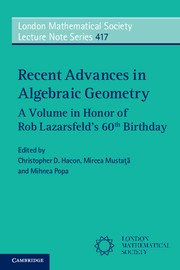Book contents
- Frontmatter
- Contents
- List of contributors
- Preface
- 1 The effect of points fattening in dimension three
- 2 Some remarks on surface moduli and determinants
- 3 Valuation spaces and multiplier ideals on singular varieties
- 4 Line arrangements modeling curves of high degree: Equations, syzygies, and secants
- 5 Rationally connected manifolds and semipositivity of the Ricci curvature
- 6 Subcanonical graded rings which are not Cohen–Macaulay
- 7 Threefold divisorial contractions to singularities of cE type
- 8 Special prime Fano fourfolds of degree 10 and index 2
- 9 Configuration spaces of complex and real spheres
- 10 Twenty points in ℙ3
- 11 The Betti table of a high-degree curve is asymptotically pure
- 12 Partial positivity: Geometry and cohomology of q-ample line bundles
- 13 Generic vanishing fails for singular varieties and in characteristic p > 0
- 14 Deformations of elliptic Calabi–Yau manifolds
- 15 Derived equivalence and non-vanishing loci II
- 16 The automorphism groups of Enriques surfaces covered by symmetric quartic surfaces
- 17 Lower-order asymptotics for Szegö and Toeplitz kernels under Hamiltonian circle actions
- 18 Gaussian maps and generic vanishing I: Subvarieties of abelian varieties
- 19 Torsion points on cohomology support loci: From D-modules to Simpson's theorem
- 20 Rational equivalence of 0-cycles on K3 surfaces and conjectures of Huybrechts and O'Grady
- References
10 - Twenty points in ℙ3
Published online by Cambridge University Press: 05 January 2015
- Frontmatter
- Contents
- List of contributors
- Preface
- 1 The effect of points fattening in dimension three
- 2 Some remarks on surface moduli and determinants
- 3 Valuation spaces and multiplier ideals on singular varieties
- 4 Line arrangements modeling curves of high degree: Equations, syzygies, and secants
- 5 Rationally connected manifolds and semipositivity of the Ricci curvature
- 6 Subcanonical graded rings which are not Cohen–Macaulay
- 7 Threefold divisorial contractions to singularities of cE type
- 8 Special prime Fano fourfolds of degree 10 and index 2
- 9 Configuration spaces of complex and real spheres
- 10 Twenty points in ℙ3
- 11 The Betti table of a high-degree curve is asymptotically pure
- 12 Partial positivity: Geometry and cohomology of q-ample line bundles
- 13 Generic vanishing fails for singular varieties and in characteristic p > 0
- 14 Deformations of elliptic Calabi–Yau manifolds
- 15 Derived equivalence and non-vanishing loci II
- 16 The automorphism groups of Enriques surfaces covered by symmetric quartic surfaces
- 17 Lower-order asymptotics for Szegö and Toeplitz kernels under Hamiltonian circle actions
- 18 Gaussian maps and generic vanishing I: Subvarieties of abelian varieties
- 19 Torsion points on cohomology support loci: From D-modules to Simpson's theorem
- 20 Rational equivalence of 0-cycles on K3 surfaces and conjectures of Huybrechts and O'Grady
- References
Summary
Abstract
Using the possibility of computationally determining points on a finite cover of a unirational variety over a finite field, we determine all possibilities for direct Gorenstein linkages between general sets of points in ℙ3 over an algebraically closed field of characteristic 0. As a consequence, we show that a general set of d points is glicci (that is, in the Gorenstein linkage class of a complete intersection) if d ≤ 33 or d = 37, 38. Computer algebra plays an essential role in the proof. The case of 20 points had been an outstanding problem in the area for a dozen years [8].
For Rob Lazarsfeld on the occasion of his 60th birthday
1 Introduction
The theory of liaison (linkage) is a powerful tool in the theory of curves in ℙ3 with applications, for example, to the question of the unirationality of the moduli spaces of curves (e.g., [3, 26, 29]). One says that two curves C, D ⊂ ℙ3 (say, reduced and without common components) are directly linked if their union is a complete intersection, and evenly linked if there is a chain of curves C = C0, C1, …, C2m = D such that Ci is directly linked to Ci+1 for all i. The first step in the theory is the result of Gaeta that any two arithmetically Cohen-Macaulay curves are evenly linked, and in particular are in the linkage class of a complete intersection, usually written licci. Much later Rao [23] showed that even linkage classes are in bijection with graded modules of finite length up to shift, leading to an avalanche of results (reported, e.g., in [19, 20]). However, in codimension > 2 linkage yields an equivalence relation that seems to be very fine, and thus not so useful; for example, the scheme consisting of the four coordinate points in ℙ3 is not licci.
A fundamental paper of Peskine and Szpiro [22] laid the modern foundation for the theory of linkage.
- Type
- Chapter
- Information
- Recent Advances in Algebraic GeometryA Volume in Honor of Rob Lazarsfeld’s 60th Birthday, pp. 180 - 199Publisher: Cambridge University PressPrint publication year: 2015



